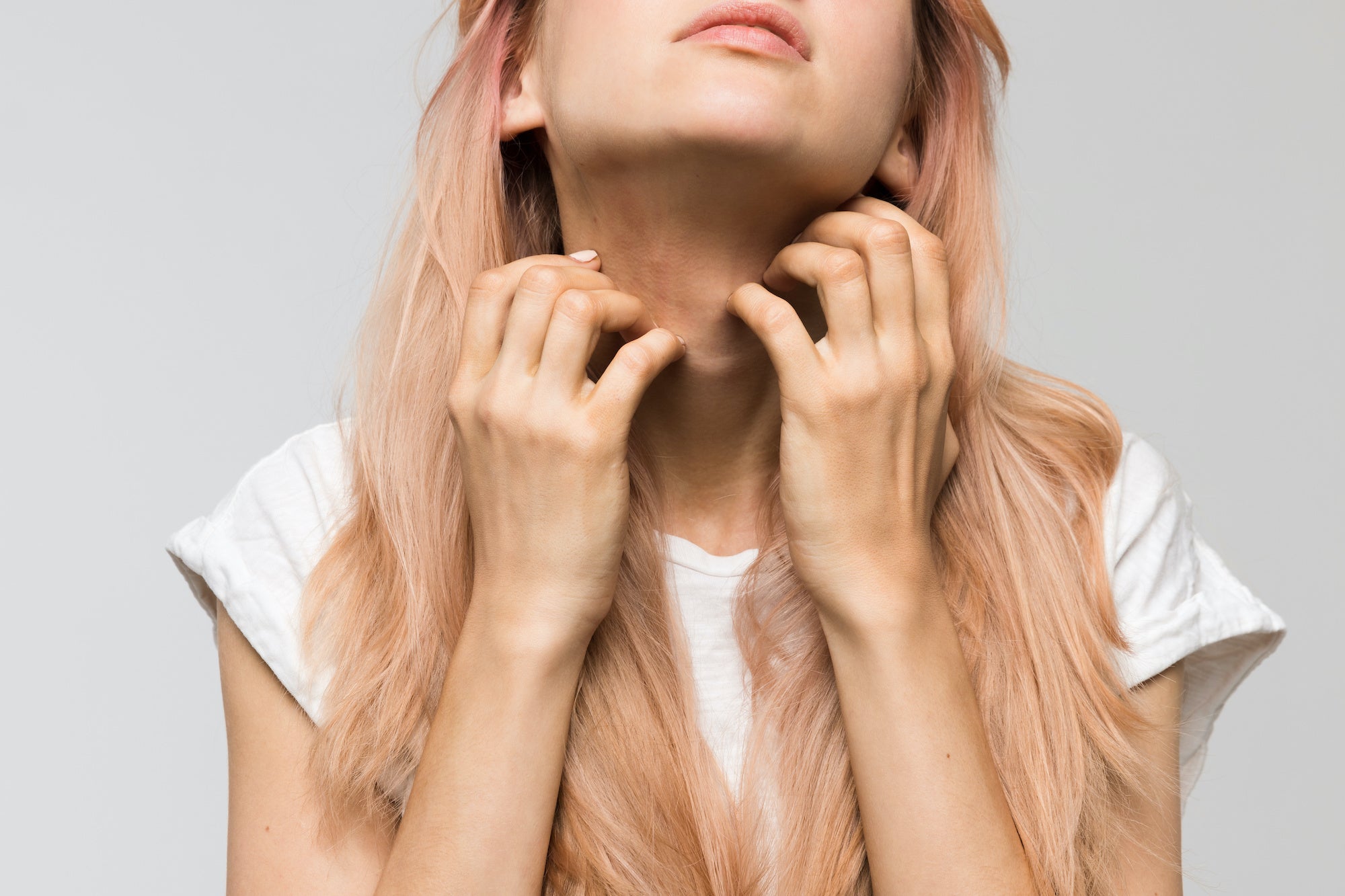
The Lowdown on Skin Allergies: Your Skincare Might Be Breaking You Out
Ever tried a new product only to have your face explode like Mount Vesuvius? Your skin erupts, red and furious, with bumps and dry patches as far as the eye can see. You’re left quaking in the aftermath, with only one despairing thought in mind:
Why?
Maybe it’s karmic retribution for cutting off that guy in traffic yesterday. Or maybe, just maybe, it’s allergies.
When we say “allergies,” you probably think about hay fever, food allergies, animal fur, or even bee stings. (Yeah, that scene in “My Girl” still makes us cry.)
But there’s also a type of allergic reaction that occurs on your skin — for example, the rash you experience if you touch poison ivy. This is called contact dermatitis, and it may be the root of your awful skincare reactions.
The Ins and Outs of an Allergic Reaction
First, let’s get back to the basics. What does it mean to have an allergic reaction?
An allergy is when a person has an oversensitivity to any substance, like peanuts, pollen, or latex. This substance is known as an allergen, and your body does not like it.
If you ingest or come into contact with an allergen, your body mistakenly thinks that the allergen is going to do damage, and reacts violently to fight it off. This search-and-destroy response from your immune system is an allergic reaction, and it can manifest in all sorts of different ways.
Enter contact dermatitis.
Contact dermatitis refers specifically to allergic reactions triggered by touching an allergen (rather than eating or inhaling one). Again, that poison ivy rash is a prime example.
Not every case of contact dermatitis indicates an allergy, though. There are two different types of contact dermatitis: allergic and irritant.
Irritant dermatitis involves exposure to a harsh substance like bleach or acid, which would cause bad reactions in anybody...with or without allergies! Dermatitis from this type of exposure isn’t considered an allergy because it’s not just your immune system overreacting. No, that acid is 100% burning you, whether your body tries to fight it or not.
Allergic contact dermatitis is the reaction you’re more likely to encounter through skincare. After all, most companies aren’t going to spike their products with universally irritating ingredients. That’d be counterproductive! Instead, ingredients safe for most people make your overprotective body go haywire, and the resulting allergic reaction wreaks havoc on your skin and your sanity.

Contact dermatitis can occur anywhere on your body, but the face is a common site. The skin on our faces is particularly sensitive already, so when we start adding potentially upsetting cosmetics to the mix, things can go downhill quickly.
Recognizing the Symptoms of Contact Dermatitis
If your face kicks off an allergic reaction, it’ll be pretty hard to miss. Symptoms of an allergic reaction on the face can include:
- Redness or inflammation
- Appearance of hives or a rash
- Skin discomfort (burning, itching, or stinging)
- Swollen lips or tongue
- Irritated eyes (red, itchy, swollen, or watering)
- Parched skin
- Small blisters
Allergy Bumps vs. Acne
If you’re already accustomed to severe acne flare-ups, it’s sometimes challenging to pinpoint an allergic reaction. While some can appear within seconds, others develop gradually over hours, days, or even years of exposure.
One thing to look for in an allergic reaction is the characteristic red rash, which will be extremely itchy. Swelling or puffiness is another telltale sign.
Also, think back over any products you may have used on the affected patch of skin. Have you tried any new lotions or creams? Did your rash first pop up in the same spot where you just dabbed that new perfume? Or maybe your rash has been getting worse over time, appearing just along the swoop of cheekbone that you like to dust with bronzer.
Look for any products that seem to coincide with the location or timing of your rash, and you may quickly realize whether it’s acne or an allergic reaction.
Common Ingredients That Trigger Skin Allergies
So you have sensitive skin, and you want to start checking ingredient lists for potential allergens. Sensible! But also a difficult task, as everyone’s body reacts differently.
Some frequent offenders in skincare include dyes or preservatives like formaldehyde, as well as alpha-hydroxy acids (AHA), especially when present in higher percentages. Synthetic fragrances are also a huge culprit, even in products that claim to be unscented.
Almost any kind of cosmetic could set off an allergic reaction, depending on your immune system. Reactions are commonly reported from sunscreen, moisturizers, soaps, deodorants, lip stains, eye makeup, hair dye, nail polish, and more.

Caring for an Allergic Reaction on Your Face
This probably goes without saying, but if you’re allergic to a product, stop using it ASAP.
If you’re experiencing a mild allergic reaction already, cleanse your skin with a gentle face wash using cool or lukewarm water.
If the rash is crusty or painful, you may wish to apply wet dressings or petroleum jelly to protect your vulnerable skin. This can be a risk for acne sufferers, though, as heavy ointments may clog your pores and contribute to new breakouts.
If you are having a severe allergic reaction, consult a medical professional immediately! Serious reactions can result in anaphylaxis, a potentially life-threatening condition that can block your airways.
Avoiding Allergy Triggers in Skincare
Without knowing your exact allergies, you may struggle to guess which products will trigger a reaction. But there are a few tips that can help you avoid a full-blown allergic flare-up!
- Look at the labels. Is the ingredient list a mile long? The more ingredients in a product, the more likely you’ll have a terrible reaction to something inside.
- Spray all your fancy perfumes and body mists onto your clothes instead of your skin. You’ll still smell magical but with less chance of setting off your allergies.
- Do a patch test. When you finally get your hands on that new product, don’t immediately slather it on your face. First, apply a small amount inside your elbow and wait 2-3 days. Yes, it requires exercising some patience. But if you see signs of swelling, itching, or redness, you’ll be glad you started on your arm instead of your face.
- Don’t blindly trust all skincare labels. Some of those gentle-sounding claims are just empty promises.
- Read reviews! Are other consumers experiencing a lot of bad reactions? There may be a common allergen lurking inside that product. Instead, try to identify products with high ratings across the board, like our Luminous Clear Skin Kit. We focus on using nourishing, natural ingredients rather than harsh synthetics, making allergic reactions extremely rare! Plus, the kit balances oil production, helps fight acne breakouts, and is suitable for all skin types. Is there such a thing as a win-win-win?

Skin allergies are no joke, but a little mindfulness will go a long way to help you escape the cycle of rashes and breakouts. Now you’ve got the knowledge — time to go put it to use!





